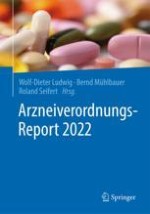2022 | Anomalien der Urogenitalorgane | OriginalPaper | Buchkapitel
33. Nieren-, Harnwegs- und Prostataerkrankungen
verfasst von : Prof. Dr. med. Bernd Mühlbauer, Prof. Dr. med. Hartmut Oßwald
Erschienen in: Arzneiverordnungs-Report 2022
Verlag: Springer Berlin Heidelberg











